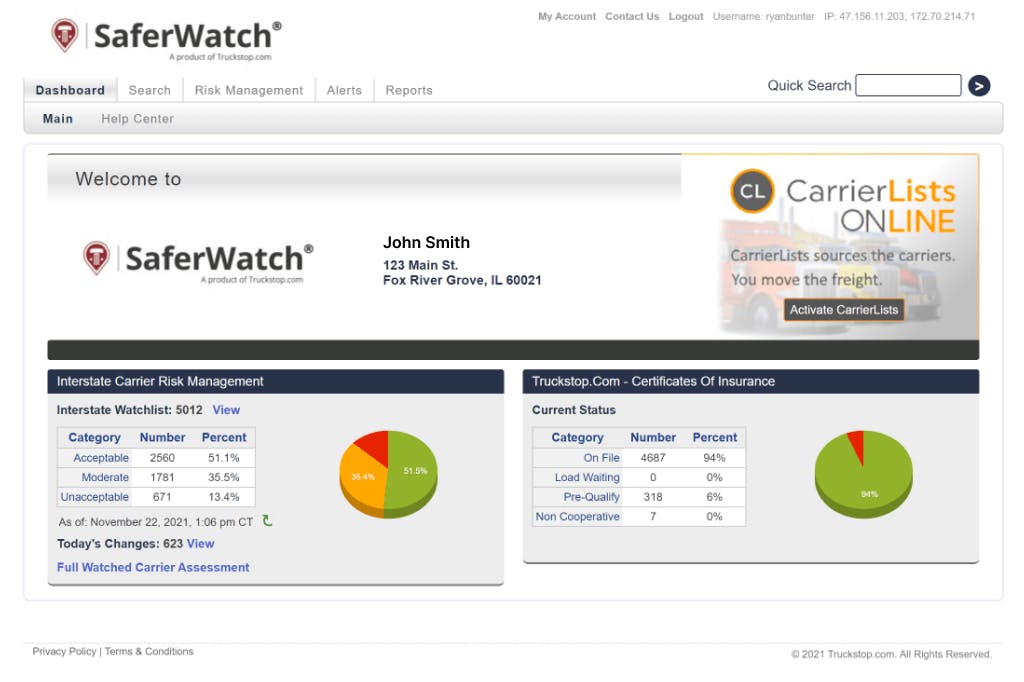Everything Carriers & Brokers Need to Know About CSA Scores

Find your next load
Make more money starting now.
A CSA (compliance, safety, accountability) rating can make or break a carrier’s profitability, reputation, and career.
In fact, CSA scores are critical and can determine a carrier’s success. CSA scores are assigned to a motor carrier’s DOT number rather than a driver’s personal record. The lower the CSA score, the better. Carriers with low CSA scores often get access to preferred loads and lower insurance premiums. If a carrier doesn’t manage the CSA score well, their scores go up. A high SCA score can result in more frequent DOT inspections, lost relationships with brokers, and even canceled insurance coverage.
But what is a CSA score, how does it work for drivers, and why is it essential to brokers?
What is the CSA program?
The CSA program is safety compliance and enforcement of the FMCSA (Federal Motor Carrier Safety Administration). This program holds drivers and motor carriers accountable for their roles in road safety.
The CSA program identifies motor carriers with safety issues and prioritizes them for interventions such as warning letters and investigations. The FMCSA holds the safety record of each carrier in its SMS (safety measurement system), and updates it monthly with new data from roadside inspections.
Here’s what SMS data considers:
- The number of inspections and safety violations
- The severity of any safety violations and crashes
- The timing of the violation (more recent events are weighted heavier)
- The number of trucks that trucking companies operate as a carrier
- The number of critical violations found during the investigation
What is a CSA score?
The FMCSA uses CSA scores to identify high-risk motor carriers that might require interventions. Only the violations that occur while operating commercial vehicles, not personal vehicles, are included in the calculation of a CSA score.
A carrier’s score is based on the performance data of its drivers. As a broker, it’s essential to check CSA scores, so you know you’re working with safe, compliant carriers.
The CSA BASICs
The FMCSA uses BASICs—Behavior Analysis and Safety Improvement Categories—to determine a motor carrier’s safety performance and compliance. A carrier’s percentile ranking in each of these categories calculates their total CSA score.
Let’s review each BASICs category in detail to find out what they include.
Unsafe driving
The Unsafe Driving BASIC prioritizes interventions for repeated unsafe behaviors, such as:
- Inattention
- Improper lane change
- Reckless driving
- Speeding
- Using a mobile phone hands-on
- Texting
Crash indicator
The crash indicator BASIC identifies patterns of high crash involvement and includes any state crash reports dating back to the last two years.
Any crashes that involve commercial motor vehicles are reportable if they:
- Result in injury or fatality
- Require a vehicle towing from the crash scene
The crash indicator BASIC is not public and is only available to a motor carrier who’s logged into its own safety profile and enforcement staff.
HOS compliance
Hours-of-service compliance requires you to follow the HOS regulations and set a time for a break. This regulation ensures drivers get proper rest to stay awake and alert to respond to any roadside situations quickly.
Visit the FMCSA website for the latest information and regulations on HOS.
Vehicle maintenance
Proper vehicle maintenance plays a crucial role in a safe road environment. That’s why it’s essential to get the carriers you’re working with to conduct pre- and post-trip inspections, record any vehicle defects, and perform maintenance and repairs before they operate the vehicle.
Controlled substances/alcohol
Drivers and carriers are prohibited from taking any drugs or alcohol before or while driving.
Misusing over-the-counter and prescription medication or consuming illegal drugs and alcohol impair driving abilities. It’s not only illegal, but it’s dangerous for drivers and anyone on the road. Even having containers of alcoholic beverages in the vehicle–open or not–is a violation.
Hazardous materials compliance
The hazardous materials (HM) compliance BASIC includes following regulations to give special attention to hazardous packages. This includes proper packaging, marking, labeling, placarding, loading, and unloading hazardous materials.
The carriers you’re working with must also understand tank specification testing, attendance, and leakage regulations.
Driver fitness
Keeping up on driver qualification files is the key to performing well in this BASIC. You must ensure that the required files of each driver include valid CDLs (commercial driver’s licenses), state driving records, medical certificates, and employment applications.
Note: Don’t confuse the driver’s fitness with the driver’s physical fitness. This BASIC doesn’t consider anything related to weight, BMI, or neck size.
Calculating CSA Scores
You already know what factors play a role in calculating CSA scores. But how does the pointing system work?
FMCSA assigns points to carriers, ranking the number and severity of violations and accidents on a scale from 0 to 100. The time when the offense took place, and the number of miles traveled per vehicle play a significant role in calculating CSA points.
For example, a carrier with two violations in three total inspections is more likely to rank with a higher percentile than a carrier with two violations in nine total inspections. The higher the percentile, the more dangerous the carrier is for the road.
Some BASIC violations carry more weight than others. Let’s look at some of the BASIC violation examples and what points they’re associated with.
10-point violations:
- Texting or using a hand-held mobile phone while driving
- Reckless driving
- Speeding: going 15 or more MPH above the speed limit
- Speeding in a construction zone
- Driving while being fatigued or physically ill
- Driving under the effect of drugs or alcohol
8-point violations:
- Unfit or unqualified driver
- Not holding a proper or valid CDL
7-point violations:
- Not using a seat belt
- Speeding 11-14 MPH above the speed limit
- Requiring drivers to drive for more than 11 hours
- 11-, 14-, and 60/70-hour rule violation
- Providing inaccurate information on the RODS (record of duty status)
- Improper load securement
6-point violations:
- Headlamps, tail lamps, brake lamps, or turn signals not operating properly
- Obscured lamps or reflectors
5-point violations:
- Following other vehicles too closely
- Not obeying a traffic control device
- Improper lane change or passing
- Taking a route that requires the vehicle to operate above the speed limit
- No RODS available
What is a good CSA-e percentile?
There isn’t a specific definition of what constitutes a good CSA score or a bad CSA score. There’s no minimum score that determines when the FMCSA will take action. Instead, CSA points are comparative, and CSA scores work in relation to the scores of other similar carriers.
However, the FMCSA has certain intervention thresholds. Violation citations that place a carrier above the threshold triggers an investigation.
- General Carriers: 65% threshold for the HOS compliance, unsafe driving, and crash indicator BASICs. 80% threshold for driver fitness, vehicle maintenance, and controlled substances/alcohol.
- Hazardous Materials Carriers: The same thresholds as general carriers apply, plus an 80% threshold for hazardous materials compliance.
This information helps brokers evaluate carriers to add to their networks.
The 4 main categories of FMCSA ratings
If a carrier is chosen for a CSA compliance check, it will result in one of the following ratings:
- No Rating: This is given to carriers that have not yet undergone an audit.
- Satisfactory: Carriers that meet or exceed FMCSA guidelines for safety practices are deemed satisfactory.
- Conditional: Auditors may rate a carrier as conditional if an audit determines that most of the FMCSA safety guidelines are being followed, but there is some need for intervention or correction.
- Unsatisfactory: An unsatisfactory rating applies to trucking companies where audits have uncovered significant deficiencies in FMCSA safety guidelines.
When reviewing carriers’ safety and compliance, most brokers avoid trucking companies with conditional or unsatisfactory ratings.
Why CSA-e percentiles are important for brokers
As a freight broker, you can use CSA percentiles combined with other data points and reports to qualify and vet carriers and drivers into your network. Most importantly, CSA-e scores can help you mitigate the violation and crash risks and run your brokerage business smoothly.

Use SaferWatch® to automate CSA score monitoring
Whether you’re experienced with checking CSA percentiles or you’re new to the process, doing it manually can be extremely tedious and time-consuming, and the success of your brokerage hinges on the safety of the carriers you work with. You need to know that the carrier CSA data you’re depending on is accurate.
That’s why it’s important to use a reliable automation tool like SaferWatch® to help you monitor carrier compliance and safety status. SaferWatch® is designed specifically for freight brokers to save you time, mitigate compliance risks, and source quality carriers faster.
Schedule a demo today to learn more about efficiently monitoring your carrier network.
Get helpful content delivered to your inbox.
Sign up today.
Find high-quality loads fast, get higher rates on every haul, and access tools that make your job easier at every turn.





